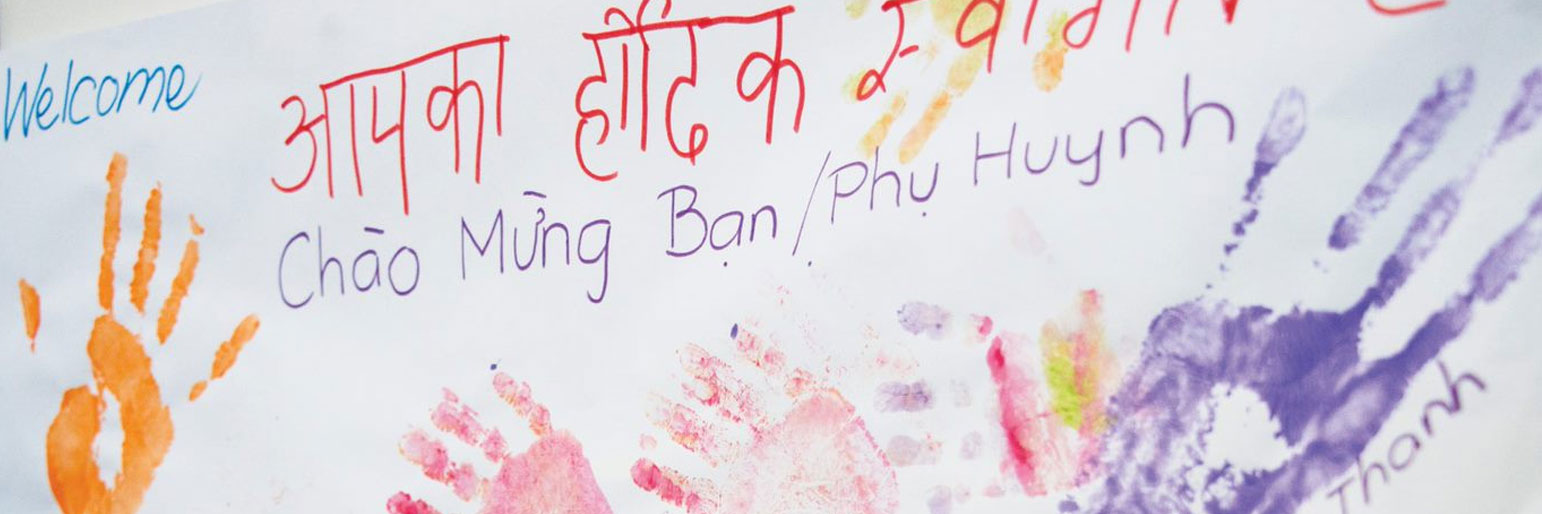Handprint welcome sign
Belonging together
Children and families develop their sense of belonging at playgroup through their experiences and connections within the play space.
Activity
Adults and children place their handprints on a large piece of cardboard or fabric to make a welcome sign for playgroup.
What you'll need
- Large cardboard/paper or fabric (such as calico or an old sheet)
- Poster paint
- Trays for paint
- Permanent markers
- Bucket of water, flannel and towel
- Cable ties/string
Words to use
- Welcome
- Handprint, thumb, fingers
- Left/right
- Writing/drawing
- Wet/dry
- Slippery
- Top/bottom
- Edge
- Upside-down/right-way up
Questions to discuss
- How do you say welcome in your home language?
- How many fingers on each hand?
- Can you see different size handprints? Who might they belong to?
Learning through play
Ways to develop numeracy through play
- Talk about left/right hands as you put each hand in the paint and make a print.
- Count how many fingers on each hand.
- Estimate how many handprints are on the sign.
- Quantify/count the handprints – How many red prints can you see?
- Compare the different sized prints – who has larger handprints and who has smaller ones?
- Use directional/positional language such as top, bottom, up, down, side, edge, upside-down when deciding where to put your prints.
Ways to develop literacy through play
- Discuss with the group the purpose of the sign.
- Ask families/children to write their names under their handprint.
- Ask families to write welcome in their home language.
- Talk about different ways to say welcome/hello in other languages.
- Talk about where each family originated.
Extensions and variations to this activity
- Acknowledge Aboriginal people as the traditional custodians of this land we now call Australia. Know the name of your local area, eg refer to the Adelaide Plains as the home of the Kaurna people, the Lower Murray/Coorong/Lakes as the home of Ngarrindjeri people and explain connection to Culture and Country and its continuing importance.
- Make a welcome to country sign eg the Kaurna people who lived on the Adelaide plains. Say “Marni naa pudni Kaurna yarta-ana.” ‘Welcome to Kaurna country’ (Lewis Yerloburka O’Brien).
- On a large map of the world mark where each family comes from. Put a string from the place to a tag with the families’ names or a photo.
- Make a large belonging tree with photos of each family on cardboard leaves.
- Make a smaller belonging tree with fingerprint leaves for each person.
Supporting parent engagement in play
Play prompts:
Questions to ask:
- How do you say ‘welcome’ in your home language?
- What do you enjoy most about living in South Australia? Or your local neighbourhood? What helps you to feel connected?
Parents or carers can:
- Comment on what their children are doing (say what you see).
- Talk in their home language.
- Use literacy and numeracy words (see words to use section above).
- Help their children to carefully make a handprint on the sign.
- Do their own handprint.
- Write their names under each handprint.
- Write welcome in their home language.
- Help their child to clean their hands.
- Use words such as left/right, top, bottom, fingers, thumb, hand, slippery, slimy, soapy, rub and scrub as you do your handprint and wash your child’s hands.
You can help families by:
- Modelling what you want them to do.
- Talking to them about the focus of the activity and what children might be learning.
- Writing up words that go with the activity.
- Making suggestions on what families can do at home.
Related Great Start activities
Great Start activities are for parents and carers to do with their children.


